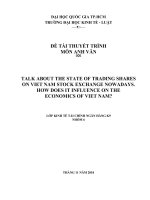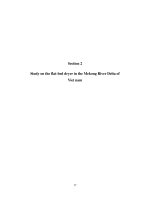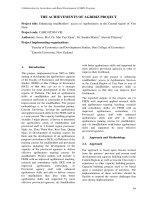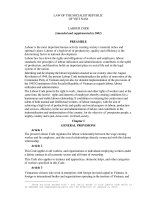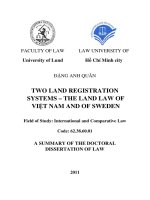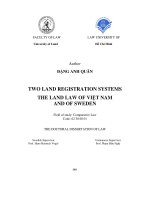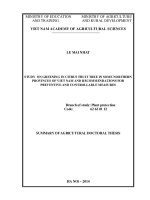EXPORT - IMPORT OF VIET NAM
Bạn đang xem bản rút gọn của tài liệu. Xem và tải ngay bản đầy đủ của tài liệu tại đây (171.51 KB, 6 trang )
PRESENTATION
EXPORT – IMPORT
I. Introduction
International trade has appeared a long time in human history. It is the exchange of goods and
services between countries, base on parity exchange to give the benefit to each country.
Example: Amber Road, Silk Road: It was formed in 2nd century BC and It has a length of
about 4,000 miles. Start from China, through Mongolia, India, Afghanistan, Kazakhstan, Iran, Iraq,
Turkey, Greece, around the Mediterranean and to Europe. Silk Road was considered to be a system
way of the biggest trade in the world in Ancient time. It gave to China many many Gold, this is a
real story: Chinese sell the silk by weigh it and receive gold as the same weight. That means 1kg
silk = 1kg gold.
SO the most important in International trade is Export and Import.
1. Definition of Import:
- A product or service brought into one country from another. Why?
- Many countries are not able to produce some products efficiently or can not meet
demand and they need to import. ex OIL, machine,
2. Definition of Export:
- A product or service that is sold to another country. Why?
- Some countries have many many goods that they can not use it all. So they sell it to
another country to get more profit and expand the market. Viet Nam exports rice,
clothes, fruit,
II. Advantages of EXPORT
Increased profitability
On average, businesses that export are more profitable than those who do not export,
according to Austrade. This is largely because foreign markets are more diverse, with consumer
habits and needs different in each country, and thus can offer increase opportunities for certain
products or services that don't currently elicit any demand at home.
With most of the world's consumers living outside of Australia, the world can become your
oyster if you are able to identify a gap in the overseas market and reduce your dependence locally.
Even if your product or service is already popular with the domestic market and you are turning
over a profit, you can still benefit from exporting overseas if demand is strong.
For instance, the Australian wine market is inundated with different types and brands at
various price points, making it difficult for a wine company to stand out or gain traction locally.
However, in China, there is a strong demand for imported wine driven by improved living standards
and increased disposable incomes. Wine is also increasingly seen as a 'status symbol', and in 2011,
China was Australia's fastest-growing wine export market with sales rising 23 per cent by value.
Spreading risks
The adage 'don't keep your eggs in one basket' is true here, as exporting allows your business
to spread your risks across different markets- so that if one market suffers from a recession, lowered
demand or changed preferences- your investment, sales and profits won't be as significantly
impacted.
In fact, exporting is a good way of balancing your growth as you can target new markets
when there is low demand at home due to seasonal fluctuations. For instance, summer in Australia
is generally winter in the Northern hemisphere, meaning that if your company produces seasonal
goods such as swimwear, sunglasses and certain fruits that are popular only during summer, they
can still be sold overseas when the temperature dips.
Economies of scale
Exporting allows you to take advantage of economies of scale, which refers to lowered
average costs as a result of expanded operations, hence leading to increased productivity and
efficiency. This usually works better if you have a 'universal' product or service that can be sold to
most other parts of the world without significant modification.
For example, a firm that produces organic skincare products may appeal to many markets
around the world and hence to the 'global consumer', regardless of where this consumer lives. This
is, of course, no determination of success, but a product that doesn't require any modifications will
lower costs of production and marketing. Products are also increasingly sold online, further
reducing any overhead costs.
Enhanced innovation
Different markets invariably have different and often new ideas, management practices,
marketing techniques and ways of competing that you would not have otherwise experienced at
home, according to Export Victoria.
For instance, business practices are different in the Middle East than in Australia as they are
largely dependent on religious and cultural values. An Australian business any that has successfully
exported their goods and services there is Aconex, a developer of document management software
and Internet-based project collaboration.
"When we started our operation there, we arrived a few weeks before Ramadan [the Muslim
month of fasting], when the whole region slows down," founder Leigh Jasper told the Sydney
Morning Herald.
He also noted that business in the Middle East is very relationship-driven, and that he found it
challenging to get paid on time in the region. He overcame this by negotiating partial payment so
the business wasn't "out of pocket".
This example shows that exposure to various working environments - and coming up with
new strategies to circumvent any obstacles - will allow your business to become more innovative,
competitive and poised to cope with changing circumstances.
There are plenty of benefits with exporting, but like with any other business initiative, you
should also consider the risks that come with it. You should always research the country you intend
to export to and ensure they do not pose a high payment or business risk - or if they do, that you
have the capacity to address them.
III. What difficulties does Vietnam face in exporting its products?
Brands are not popular.
Protectionism of imported countries.
Poor quality of goods (low tech, unspecialized worker, not meet the market’s demand, cargo
security Ex: Food hygiene and safety, toxic Pb, Hg).
Dumping, competitive price Ex China.
There are not many relationship with foreigner partner (barrier for exporting )
Counterfeit.
IV. Free Trade and how good it is for both producers and
consumers.
Free trade is liberalization of trade with no government interference in the form of
regulations, tariffs, quotas or taxes, which allows producers to yield, manufacture or sell their
products within as well as outside domestic frontiers. This helped producers to price their products
at lower rates which further stimulated competition. On the downside, benefits like tax holidays and
subsidies to domestic producers were also withdrawn. Unrestricted flow of labor, materials, goods
and funds prompted several countries to enter free trade agreements.
Free trade is advantageous for consumers because increased competitiveness due to the
presence of international producers compels domestic producers to deliver high quality products at
reasonable prices that are at par with the competition. The consumer is empowered with the ability
to choose from a wide variety of the same product. In the absence of the free trade act, consumers
had limited choices in the market. Free trade came under fire because it led to monopoly in the
international markets by corporations originating in developed countries that took advantage of the
'no government intervention' policy. A grave matter of concern is the cost of damage to the
environment that will accumulate overtime and the consumer will ultimately pay a heavy price for it
in the long run which far outweighs the benefits of low-cost wide-variety products.
The main objective of adopting free trade markets was to bridge the gap between the poor and
the rich, stimulate economic growth and raise the quality of life. Corporations engaging in free trade
have been accused of exploitation of farmers, especially those belonging to poorer countries, by
coercing them to cultivate only profitable crops and paying them meagerly. If produce does not
conform to the company's desired standards, it is rejected and farmers are not even partially paid for
growing the crop on demand. The concept of free trade may sound very lucrative and it may come
across as a viable trade mechanism that brings all the market forces to perfect balance. However,
this very idea is contradicted by the fact that not everyone involved in this process is given equal
opportunity by means of fair access to resources.
V. What comparative advantages does Viet Nam have? How can
Viet nam exploit its comparative advantages?
Definition of 'Comparative Advantage'
The ability of a country to produce goods or services at a lower opportunity cost than other
countries. And comparative advantage gives a country the ability to sell goods and services at a
lower price than its competitors and stronger sales margins. A country have a comparative
advantage – they can focus on what product or services that they produce.
Vietnam has low level of comparative advantages:
- Natural resources: VN has many natural resources: metal, land, beach, oil, neighboring
countries weather, travel
- Abundant labor: young population, by 2009, Vietnam’s population was about 86 milion
and we have 67% in that 86 milion was in working age.
- Because of low level of comparative advantages , it attracts foreign investors in
Vietnam.
- It made price of products, services cheaper because it doesn’t need brain storming to
produce. Ex agriculture products, Seafoods
Vietnam has exploited these comparative advantages well but they don’t develope it.
- Low level of comparative advantages maybe good for agriculture but not good for
industry. It need to use high level of comparative (high quality labor, refind material,
modern technology ). Now Vietnam does not gain high level of comparative
advantages. So Vietnam’s industrial products may be small.
- Vietnam is depend on FDI, so they can not change economic structure, can not change to
industrial country.
- Price of products from Vietnam has a low price and it has a comparative advantage but it
is low level products. Vietnam don’t use high tech and labor to change it to high level
products. Ex OIL. Vietnam exports CRUDE OIL but they can not produce refined oil so
they imports oil to use. So Vietnam have to pay lots of money to import. That higher
than money from export.
So Vietnam need to change low level of comparative advantages to higher level
VI. Viet Nam has become the 2
nd
largest rice exporter in the
world. What should Viet Nam do to maintain this position?
The situation of Vietnam’s rice export
Agriculture is the traditional industry of Vietnam, which rice is the main product. Rice
production for exporting in Vietnam to other countries brings economic values.
Since “Doi Moi” policy, Vietnam’s rice industry has made a lot of improvements.
Figure 1 - Rice export quantity and export value of Vietnam in 2003 - 2007
Year Export Quantity (1000 tons) Export Value (1000 USD)
2003 3,813 719,916
2004 4,063 950,315
2005 5,250 1,407,229
2006 4,642 1,275,895
2007 4,558 1,489,970
Major competitors of Vietnam in exporting rice are Thailand, Myanmar, India, Pakistan, the
US and China
Nations 2012 (expected) – million tons 2011 – million tons
Thailand 7.5 10.6
Vietnam 7.2 7.1
India 6.3 4.0
Pakistan 3.5 3.1
Cambodia 1.2 1.1
How to maintain
1. Government policies
The government will offer full interest subsidies for rice exporters for three months.
Implementing policy on Management of agriculture land (protect land for rice cultivation),
increasing investment for infrastructure development in the main rice producing areas and
strengthen investment for development of infrastructure serving for socio-economics in specialized
rice producing localities.
Set up a fund to help facilitate cooperation in rice production
Restructuring the agricultural sector to increase its value and ensure its sustainable
development, improve the quality of commercial rice products and build a trademark for
Vietnamese rice.
2. Branding, Expanding Market
Strengthen trade promotion, research seeking the new and stable market such as China,
Africa
Existing market revaluation is needed to have promotion strategy, product launch.
Given the branding strategy for Vietnam’s rice
3. Improve quality
The most important issue currently was to maintain a good quality of export rice products and
target the left out export markets, especially China, since it would emerge as one of the largest
export markets for Vietnamese rice in the coming years.
Restructuring production business to long-term benefit.
Planning solutions for the commercial rice, choice of breed structure consistent with market
demand and natural conditions, soil, crop. There also need to focus on improving farming
techniques, purchasing, storage and processing for the production of rice and especially to better
control the manufacturing process for the production of rice, high value goods, for export.
Review the structure of rice varieties suitable to market demand, such as high quality rice, rice
for the grade average requirements, improves the quality of rice, the contracting procedures, flexible
payment transfer and scientific.


